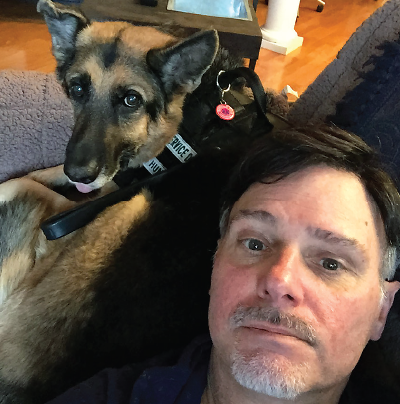Psychiatrist Edward Kantor, M.D., was having a tough time getting through the day at work.
Kantor had fallen ill in March 2009 with a severe lung infection that progressed to pneumonia, then acute respiratory distress syndrome, followed by numerous secondary complications. By the time he was discharged from the hospital in early July, he had to cope with motor, balance, and lung problems, some of which still have not fully resolved.
He got back to working about half time by December of 2009. Kantor, an associate professor of psychiatry and residency training director at the Medical University of South Carolina in Charleston, is a consultation/liaison psychiatrist, and his job demands a lot of walking around the hospital and the emergency department. He is also an expert on disaster psychiatry and has worked on aspects of emergency planning and response for over 30 years, including the Virginia Tech and Charleston church shootings.
As time went on, his condition improved slowly, but the functions of daily living did not come back easily.
Until he met Hunter.
Visiting his brother in New York, he spent some time playing with one of the family dogs, a moment that led his sister-in-law to observe that a dog—the right kind of dog—perhaps could help Kantor.
Another sister-in-law had a volunteer connection with The Seeing Eye, which raises and trains guide dogs for blind people. She led him to Hunter, a very intelligent animal who could no longer work as a guide dog after he developed seizures.
“Many of the dogs that don’t make the cut as a Seeing Eye guide dog can be amazing at other things like police K-9 work, bomb sniffing, or search and rescue,” said Kantor. “Dogs with medical problems can be hard to place, though.”
Hunter needed love and a home that could manage his medical issues, and Kantor was willing to deal with the dog’s potential frailties. Hunter also needed a purpose, and he loved to work.
“He adapted to me, and I adapted to him.”
Mere walking was a chore for Kantor, who was still on oxygen. Hunter kept him balanced on uneven ground. He pulled him up steps and kept him from falling. He countered any instability and made up for general lack of strength.
“It’s really uncanny how he’d pull if I was shifting the other way—when he was doing his job right,” he said. “Occasionally he was a little bit single-minded at first. Seeing Eye guide dogs are trained in ‘intelligent disobedience,’ and so display independent thinking at times, but we worked well as a team, and it only got better with time.”
As Kantor recovered and spent more time at work, new questions arose.
In theory, service dogs can usually move throughout the hospital, but Kantor didn’t want to disrupt the psychiatric work environment or disturb patients. No conflicts arose at first because he took Hunter only to his office in the resident education center, where no patients were seen. Going to the clinic was another matter.
“It occurred to me that you can’t have a dog in a psychiatry appointment without the dog somehow becoming part of the discussion,” he said. Soon, a different discussion emerged, one involving liability insurance and hospital lawyers.
The lawyers, though, came up with a solution—write a new job description with an animal-assisted therapy protocol that did not intrude into patient care but did allow Kantor some discretion to bring the dog into some settings at the right time—like the geriatric psychiatry unit where he rounded some weekends.
Hunter behaved well in the hospital, even with agitated, psychotic, and angry patients. “Somehow, the dog had an ability to shift the focus and make encounters less hostile,” said Kantor. “It gives you something to talk about that doesn’t threaten the patient. So he’s been a big help.”
“There have been a few cases where people with almost no memory appear to re-engage in the presence of the dog,” he said. “One day, a woman who couldn’t form complete sentences said, ‘Looking at him, you would think you should be afraid, but he’s such a gentle soul.’”
Staff on the ward were astonished.
“I’d say 90 out of a 100 people wanted the dog in the room, probably more than they wanted me in the room,” said Kantor. “Even the ones who couldn’t remember my name remembered the doctor with the dog, and that’s typically who they asked the nurses for.”
But illness eventually caught up with Hunter.
“He was with me for almost two years, and one night he had a bad seizure and stopped breathing and didn’t recover,” said Kantor. “It was pretty traumatic, actually, because we were with each other 24/7.”
Hunter died in January 2015, and even six months later, Kantor thought he wasn’t ready to bring a new dog into his life. But things changed when he got another call from The Seeing Eye’s adoption coordinator. By chance, another dog was available that seemed like a good fit for Kantor. He returned to The Seeing Eye and met Eaton, a younger, healthy dog who had done so well in his early training that he was assigned to breed new guide dogs. He had retired from that job by the time he and Kantor met and was available for adoption.
Hunter and Eaton helped Kantor in quite different ways.
“Among other things, Hunter was fully trained and had worked as a guide dog for a blind person, so he was very used to one person and was very single-minded and focused,” said Kantor. “With me, he had to adjust to a sighted person, but he was incredibly intuitive and over time adapted well.”
Eaton, in contrast, had undergone general training but not the blind-specific schooling, so their developing relationship focused more on learning to work together rather than adjusting to a new task.
Eaton soon fit in well with Kantor and his work at MUSC. “He’s quite loving and social with other dogs, babies, kids, and geriatric patients, but he still manages to maintain his focus on helping me.”
Of course, some people, with or without mental illness, are just not dog people.
“We had one patient on our geriatric unit say, ‘Get that mangy animal out of my room!’” recalled Kantor. “And we said, ‘OK, I’m sorry you feel that way. We don’t mean to intrude.’ Three days later, after he saw Eaton interacting with everybody else on the unit, he said, ‘Is it OK if I change my mind?’ We had a nice little sit-down, he stroked Eaton, and he talked about his own pets when he was a kid. I think Eaton makes a difference for many patients—certainly he makes a difference for me. The dogs changed my life.”
If at first Kantor was afraid that Hunter and Eaton would disrupt his practice, thinking about their therapeutic role and his own recovery from debilitating illness clarified the dogs’ place in his world. Their presence on the wards became intentional rather than accidental and disjunctive.
“Recovery is a process, and sometimes we need help,” said Kantor. “I was fortunately able to adapt, and I think the dogs actually made me a better psychiatrist. Sometimes the nonverbal communication you get from a patient involving an animal is even more effective than struggling to find the language to talk about something directly.” ■


